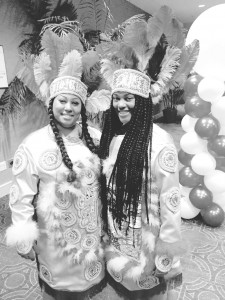Soiree of the Feathers promotes Black Indians unity, service, friendship
6th April 2015 · 0 Comments
By Fritz Esker
Contributing Writer
Despite being centuries old, the New Orleans Black Indians culture never had a ball to call its own. But that changed last weekend when the New Orleans Black Indians Alliance (NOBIA) hosted the inaugural Soiree of the Feathers.
The inaugural Soiree of Feathers took place on March 21 at the Sheraton New Orleans Hotel on Canal Street. The slogan of the event was “Bury the Hatchet, Raise the Flag.” That motto is significant because, in the past, Mardi Gras Indians tribes were rivals and sometimes fought among themselves (although 3rd Chief Shaka Zulu of the Yellow Pocahontas said these stories have been sensationalized and exaggerated over the years). Now, the NOBIA wants to emphasize unity and pride, as well as service to the community.
“We’re not together enough,” Zulu said. “Outside of the suits, we’re all friends.”

In attendance at the
New Orleans Black
Indians Alliance
(NOBIA) inaugural
Soiree of Feathers
are two Indian queens
Indians are used to performing for everyone else; this event gave them a chance to relax, socialize, and be entertained by other people for a change.
“It’s an opportunity for people to mingle in a ball setting, and get to know people outside their (Indians) suits,” said Big Chief Juan Pardo of the Golden Comanches.
The event was the brainchild of NOBIA. The organization is only one year old, but its birth was many years in the making. Big Chief Clarence A. Dalcour of the Creole Osceola and Big Chief Charles Taylor of the White Cloud Hunters wanted to stage a ball that would honor past and present Indians. After discussing their ideas with Big Chief Darryl J. Montana of the Yellow Pocahontas and Big Chief Roderick Sylvas of the Wild Tchoupitoulas, the plans began to take shape. They didn’t want to simply have a ball; they wanted to foster unity among all tribes and serve the community of New Orleans as a whole.
The Old and the Young
Aside from the food and music, the gala featured a memorial walk in honor of the ancestors, Mardi Gras Indians who have passed away. 3rd Chief Shaka Zulu of the Yellow Pocahontas said devoting a life to the Indian culture takes a real commitment of time and money. The lifestyle requires sacrifice, and the men who have devoted their lives to preserving the culture deserve to be remembered.
“If you don’t keep their legacies alive, they can be forgotten about,” Zulu said.
Staging a formal ball poses a challenge for Mardi Gras Indians that’s different from other Carnival organizations. While Mardi Gras krewe members receive costumes as part of their dues, the Indians carefully craft their own suits themselves. It’s hard to be focused on designing a beautiful suit for Super Sunday while planning or participating in a ball. But NOBIA plans to make the Soiree of Feathers an annual event.
To better serve the community, NOBIA has partnered with Children’s Hospital and Feed the Children. Zulu said the organization also plans community outreach with both the police and area youths. NOBIA seeks a constructive relationship with the New Orleans Police Department, and hopes to present local children with a positive counterpoint to some of the negative influences on the street.
The Indians plan to emphasize the importance of health and education to the youth, as well as give them opportunities to assist in tasks like sewing costumes. Eventually, work like this can lead to a young man receiving an invitation to join one of the tribes (membership in any tribe remains invite only). Aside from helping the community, it will also keep the tribes alive for generations to come.
“If you don’t have kids involved, the culture will die,” Zulu said.
Economic & Cultural Effects
The economic impact that Mardi Gras Indians have on the local economy isn’t one easily quantifiable. That information is not quantified in the New Orleans Convention & Visitors Bureau’s Visitor Profile. However, Kelley Pettus, communications director at the New Orleans Convention & Visitors Bureau, said the city welcomed 9.52 million visitors who spent a record-breaking $6.81 billion in 2014. While the exact numbers relating to the Indians’ contribution to the tourism industry can’t be ascertained, they are a vital part of the city’s culture, and the unique culture is a major reason why tourists choose to visit New Orleans.
Dr. Dugyu Zirek, assistant professor of finance at the University of New Orleans, estimated that the gross domestic product of New Orleans is $24.553 billion. Approximately 5.2 percent of this number is attributable to the arts, entertainment, recreation, accommodations, and food service.
While the amount of tourists who visit the city to see the Indians can’t be quantified, it’s easier to gauge the numbers the Indians spend to make their costumes happen. According to information provided by Douglas Finley, chief strategy officer of NOBIA, the direct material costs of manufacturing a suit averages about $3,400. Indians must purchase materials like plumes, marabou, canvas, silk, beads, and sequins. For example, ostrich plumes cost approximately $400 per pound and suits often have two pounds of plumes.
But while the Indians do benefit the city’s economy, the ultimate rewards of the culture for both the city and the men and women who participate in it extend beyond numbers and dollars.
“The culture is about more than sewing and coming out to perform one special day out of the year,” Finley said. “There are many different paths Indians take to reach (the) heart or the truth of the masking tradition. Every Indian has his or her story about what the culture means to them. Each year they set out to reflect that meaning in their sculptured work of art.”
This article originally published in the April 6, 2015 print edition of The Louisiana Weekly newspaper.



